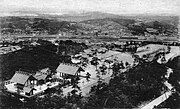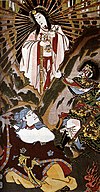Chōsen Shrine
| Chōsen Shrine | |
|---|---|
 Entrance stairway to the shrine complex, from a postcard (c. 1930s) | |
| Religion | |
| Affiliation | Shinto |
| Deity | Kunitama Okami Amaterasu Okami |
| Location | |
| Geographic coordinates | 37°33′13″N 126°58′58″E / 37.55361°N 126.98278°E |
 Former location relative to modern Seoul Former location relative to modern Seoul | |
| Korean name | |
| Hangul | 조선신궁 |
| Hanja | |
| Revised Romanization | Joseon Singung |
| McCune–Reischauer | Chosŏn Singung |
Chōsen Shrine (Japanese: 朝鮮神宮, Hepburn: Chōsen Jingū, Korean: 조선신궁; Hanja: 朝鮮神宮) was the most important Shinto shrine during the Japanese colonial period in Korea. It was built in 1925 in Seoul (then called Keijō) and destroyed soon after the end of colonial rule in 1945.
The famous architect and architectural historian
The former site of the shrine is now part of
Background

After the
State authorities at
History
The shrine was constructed in 1925, and an enshrinement ceremony held in October.
Worship at the shrine increased in the 1930s after the government began forcing people to attend.[5][6] This made the shrine and others a target of resentment; within days of Korea's liberation in 1945, many shrines were burnt down.[6]
An ethnic Korean group proposed to take over Okunitama worship after the war and convert the shrine to one worshipping Dangun but was denied by the new government.[5] Ogasawara also proposed a system where Japanese people in the colonies were seen as Amatsukami and natives were seen as Kunitsukami.[5]
After the announcement of Japan's surrender on August 15, a ceremony was held that afternoon to remove the enshrined deities.[6] The shrine was considered by the United States Army Military Government in Korea to be "enemy property".[6]
Chōsen Jingū was demolished in October 1945.
Description
The shrine ran along a straight axis of around 500 meters (1,600 ft). The main shrine was at the far end away from the entrance.[6]
Gallery
See also
- State Shinto
- Shinto in Korea
- Korea under Japanese rule
- Modern system of ranked Shinto Shrines
References
- ]
- ^ a b c Wakabayashi, Ippei. "Ahn Jung-geun and the Cultural Public Sphere" (PDF). Bunkyo University. Archived from the original (PDF) on 13 June 2011. Retrieved 31 March 2011.
- ^ a b Grayson, James H. (1993). "Christianity and State Shinto in Colonial Korea: A Clash of Nationalisms and Religious Beliefs". Diskus. 1 (2). British Association for the Study of Religions: 13–30. Archived from the original on 5 September 2011. Retrieved 27 April 2011.
- ISBN 0-9627713-0-9.
- ^ ISSN 0304-1042.
- ^ a b c d e f g h i "東アジアの都市における歴史遺産の保護と破壊――古写真と旅行記が語る近代――". www.gakushuin.ac.jp. Retrieved 9 October 2023.
- ^ "Chōsen Jingū". Genbu.net. Retrieved 31 March 2011.
- ^ Hiura, Satoko (2006). "朝鮮神宮と学校 : 勧学祭を中心に". Japan Society for the Historical Studies of Education. 49. National Institute of Informatics: 110–112.
- ^ ISBN 9780231123402.
- ^ Grisafi, John G (September 2016). "Shintō in Colonial Korea: A Broadening Narrative of Imperial Era Shintō". Academia.edu. University of Pennsylvania. Retrieved 13 June 2023.
External links
(in Japanese) Chōsen Jingū (plan and photographs)
- 1931 photograph Archived 4 March 2016 at the Wayback Machine






